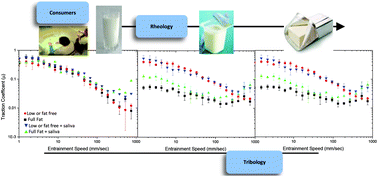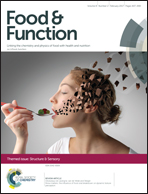Relating rheology and tribology of commercial dairy colloids to sensory perception
Abstract
This study aims to investigate the relationship between rheological and tribological properties of commercial full fat and fat-free/low fat versions of liquid and soft solid colloidal systems (milk, yoghurt, soft cream cheese) with their sensory properties. Oscillatory measurements (strain, frequency), flow curves and tribological measurements (lubrication behaviour using Stribeck analysis) were conducted. Oral condition was mimicked using artificial saliva at 37 ○C. Discrimination test was conducted by 63 untrained consumers, followed by a qualitative questionnaire. Consumers significantly discriminated the fat-free/low fat from the full fat versions (p < 0.01) in all product classes, with most common verbatim used being “creamy”, “sweet” for the full fat versus “watery”, “sour” for the fat-free samples. Flow behaviour of both versions of milk showed overlapping trends with no significant differences identified both in absence and presence of saliva (p > 0.05). Full fat and fat free yoghurts had similar yielding behaviour and elastic modulus (G′), even in simulated oral conditions. However, in case of soft cream cheese, the full fat version had a moderately higher G′ than the low fat counterpart. Even in presence of artificial saliva, there was slight but significant difference in viscoelasticity between the cream cheese variants depending on fat content (p < 0.05). Stribeck curve analyses showed that at lower entrainment velocities (1–100 mm s−1), both full fat yoghurt and soft cream cheese exhibited a significantly lower traction coefficient when compared to fat-free/low fat versions (p < 0.05), which might be attributed to the lubricating effect of the coalesced fat droplets. Surprisingly, whole and skim milks showed no significant difference in traction coefficients irrespective of the entrainment speeds (p > 0.05). Results suggest that sensory distinction between fat-free and full fat versions, particularly in semi-solid systems could be better predicted by lubrication data as compared to bulk rheology.

- This article is part of the themed collection: Structure & Sensory


 Please wait while we load your content...
Please wait while we load your content...